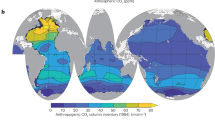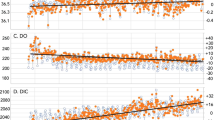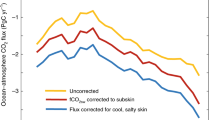The coming centuries may see more ocean acidification than the past 300 million years.
Abstract
Most carbon dioxide released into the atmosphere as a result of the burning of fossil fuels will eventually be absorbed by the ocean1, with potentially adverse consequences for marine biota2,3,4. Here we quantify the changes in ocean pH that may result from this continued release of CO2 and compare these with pH changes estimated from geological and historical records. We find that oceanic absorption of CO2 from fossil fuels may result in larger pH changes over the next several centuries than any inferred from the geological record of the past 300 million years, with the possible exception of those resulting from rare, extreme events such as bolide impacts or catastrophic methane hydrate degassing.
Similar content being viewed by others
Main
When carbon dioxide dissolves in the ocean it lowers the pH, making the ocean more acidic. Owing to a paucity of relevant observations, we have a limited understanding of the effects of pH reduction on marine biota. Coral reefs2, calcareous plankton3 and other organisms whose skeletons or shells contain calcium carbonate may be particularly affected. Most biota reside near the surface, where the greatest pH change would be expected to occur, but deep-ocean biota may be more sensitive to pH changes4.
To investigate the effects of CO2 emissions on ocean pH, we forced the Lawrence Livermore National Laboratory ocean general-circulation model5 (Fig. 1a) with the pressure of atmospheric CO2 (pCO2) observed from 1975 to 2000, and with CO2 emissions from the Intergovernmental Panel on Climate Change's IS92a scenario1 for 2000–2100. Beyond 2100, emissions follow a logistic function for the burning of the remaining fossil-fuel resources (assuming 5,270 gigatonnes of carbon (GtC) in 1750; refs 6, 7). Simulated atmospheric CO2 exceeds 1,900 parts per million (p.p.m.) at around the year 2300. The maximum pH reduction at the ocean surface is 0.77; we estimate, using a geochemical model8,9, that changes in temperature, weathering and sedimentation would reduce this maximum reduction by less than 10%.
a, Atmospheric CO2 emissions, historical atmospheric CO2 levels and predicted CO2 concentrations from this emissions scenario, together with changes in ocean pH based on horizontally averaged chemistry. b, Estimated maximum change in surface ocean pH as a function of final atmospheric CO2 pressure, and the transition time over which this CO2 pressure is linearly approached from 280 p.p.m. A, glacial–interglacial CO2 changes13; B, slow changes over the past 300 Myr; C, historical changes1 in ocean surface waters; D, unabated fossil-fuel burning over the next few centuries.
A review10 of estimates of palaeo-atmospheric CO2 levels from geochemical models, palaeosols, algae and forams, plant stomata and boron isotopes concluded that there is no evidence that concentrations were ever more than 7,500 p.p.m. or less than 100 p.p.m. during the past 300 million years (Myr). Moreover, the highest concentrations inferred from the geological record were thought to have developed over many millions of years owing to slow processes involving tectonics and biological evolution.
We estimated the effect of past changes in atmospheric CO2 levels on ocean pH by using a four-box ocean/atmosphere model8,9. Modelled processes include weathering of carbonate and silicate minerals on land, production of shallow-water carbonate minerals, production and oxidation of biogenic organic carbon, production and dissolution of biogenic carbonate minerals in the ocean, air–sea gas exchange of carbon, and transport by advection, mixing and biological processes.
In a series of simulations, atmospheric pCO2 was varied linearly from the pre-industrial value (about 280 p.p.m.) to stabilization values from 100–10,000 p.p.m. over time intervals of 10–107 yr. For each simulation, we recorded the maximum predicted perturbation in pH in the surface-ocean boxes (Fig. 1b). When a CO2 change occurs over a short time interval (that is, less than about 104 yr), ocean pH is relatively sensitive to added CO2. However, when a CO2 change occurs over a long time interval (longer than about 105 yr), ocean chemistry is buffered by interactions with carbonate minerals, thereby reducing sensitivity to pH changes11.
Based on the record10 of atmospheric CO2 levels over the past 300 Myr and our geochemical model8,9, there is no evidence that ocean pH was more than 0.6 units lower than today. Our general circulation model results indicate that continued release of fossil-fuel CO2 into the atmosphere could lead to a pH reduction of 0.7 units. We conclude that unabated CO2 emissions over the coming centuries may produce changes in ocean pH that are greater than any experienced in the past 300 Myr, with the possible exception of those resulting from rare, catastrophic events in Earth's history8,12.
References
Houghton, J. T. et al. (eds) Climate Change 2001: The Scientific Basis (Contribution of Working Group I to the Third Assessment Report of the IPCC, Cambridge Univ. Press, Cambridge, 2001).
Kleypas, J. A. et al. Science 284, 118–120 (1999).
Riebesell, U. et al. Nature 407, 364–367 (2000).
Seibel, B. A. & Walsh, P. J. Science 294, 319–320 (2001).
Caldeira, K. & Duffy, P. B. Science 287, 620–622 (2000).
Metz, B., Davidson, O., Swart, R. & Pan, J. (eds) Climate Change 2001: Mitigation (Contribution of Working Group III to the Third Assessment Report of the IPCC, Cambridge Univ. Press, Cambridge, 2001).
Marland, G., Boden, T. A. & Andres, R. J. Global, regional, and national CO2 emissions. Trends: A Compendium of Data on Global Change http://cdiac.esd.ornl.gov/trends/emis/tre_glob.htm (2002).
Caldeira, K. & Rampino, M. R. Paleoceanography 8, 515–525 (1993).
Caldeira, K. & Rau, G. H. Geophys. Res. Lett. 27, 225–228 (2000).
Crowley, T. J. & Berner, R. A. Science 292, 780–781 (2001).
Caldeira, K., Berner, R., Sundquist, E. T., Pearson, P. N. & Palmer, M. R. Science 286, 2043 (1999).
Beerling, D. J. & Berner, R. A. Global Biogeochem. Cycles 16, 101–113 (2002).
Sanyal, A., Hemming, N. G., Hanson, G. N. & Broecker, W. S. Nature 373, 234–236 (1995).
Author information
Authors and Affiliations
Corresponding author
Ethics declarations
Competing interests
The authors declare no competing financial interests.
Rights and permissions
About this article
Cite this article
Caldeira, K., Wickett, M. Anthropogenic carbon and ocean pH. Nature 425, 365 (2003). https://doi.org/10.1038/425365a
Issue Date:
DOI: https://doi.org/10.1038/425365a
This article is cited by
-
Impact of Climate Change on the Dynamic Processes of Marine Environment and Feedback Mechanisms: An Overview
Archives of Computational Methods in Engineering (2024)
-
Contrasting patterns in pH variability in the Arabian Sea and Bay of Bengal
Environmental Science and Pollution Research (2024)
-
Effects of acidification on nitrification and associated nitrous oxide emission in estuarine and coastal waters
Nature Communications (2023)
-
Abundant Sulfitobacter marine bacteria protect Emiliania huxleyi algae from pathogenic bacteria
ISME Communications (2023)
-
Anthropogenic acidification of surface waters drives decreased biogenic calcification in the Mediterranean Sea
Communications Earth & Environment (2023)
Comments
By submitting a comment you agree to abide by our Terms and Community Guidelines. If you find something abusive or that does not comply with our terms or guidelines please flag it as inappropriate.




